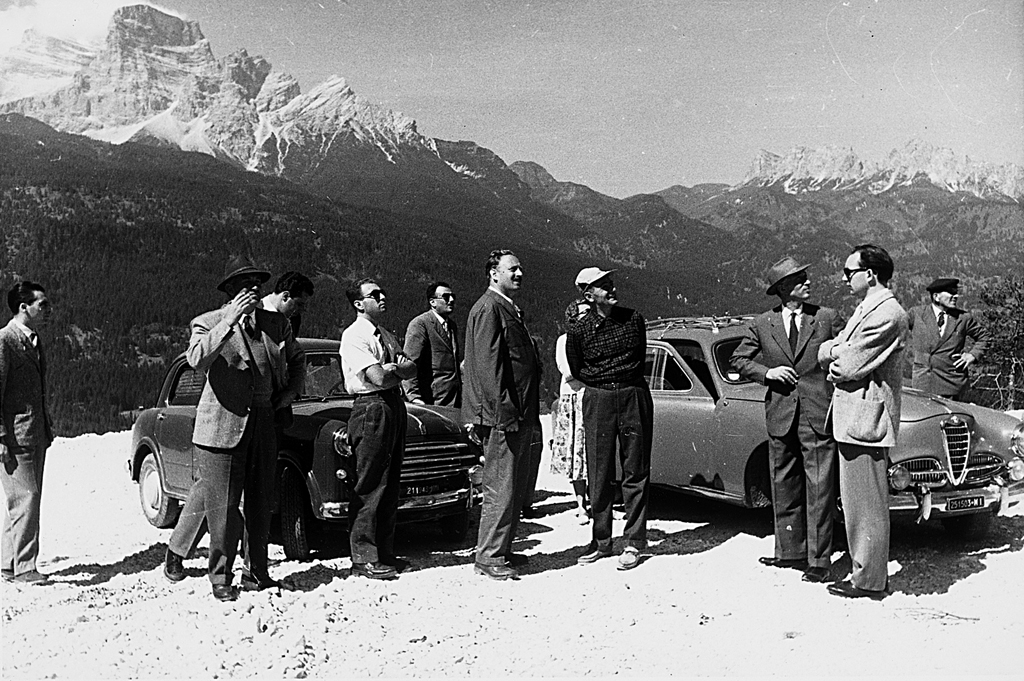Gellner, a great example of glocalism

[...] Let’s begin, at this point, to consider the maximum endeavour by Gellner, the Colonia (Eng.: summer camp building) of Borca, and in particular the central building, used for meetings, dominated by the cabin motif, which is also repeated in the Church, on the top of the hill. Hence, a triangular glass wall, which can be invested with the usual lively sequence of scans, is defined; the trestle that supports each glass designs an admirably diverse and irregular frame, with junctions, intersections, partitions entrusted to an unpredictable casuality, linked to a fitting inspiration. The massive structures conceived and realised in the Colonia offer us other inspired example of this happy, spontaneous, unrestrained commitment to aleatory criteria, as a rolling of dices. If we still remain in the central, cabin-like space, we catch sight of many illuminated bodies hanging from the ceiling, and well, they too adjust themselves to that very same rhythm trusted to an unpredictable casuality, because of the strings that hold them up and that conduct electricity, which are placed on different heights, making the bulbs dangle in a similarly irregular pattern, that comes to play in the animation of the container, in making it bright, reactive in its various points. If we then go out and walk through the long corridors, or flank the low surrounding walls, we’ll be able to see another one of Gellner’s extraordinary inventions. Those surfaces are interrupted by little windows for the obvious necessity of inner light, or to give the chance for those inside to have brilliant viewpoints of the external environment, invaded by the thriving vegetation. But even in designing these complementary and elements – details – the architect carries out his skillful work of fusion of opposites; that is clearly detectable in the windows, which follow the usual criteria of lucid and unyielding rationalism, are framed inside rectangular schemes, reiterated, moreover, by the frames themselves, which are quadrangolar as well, but whose sizes, again, are pleasantly variable, as if, letting go of the coding of inorganic and artificial matter, they embraced a new one, typical of organic substances, two of whose kind are never found. The architect freely playes on the alternation of formats, now smaller, now bigger, and of their dislocation, placing them closer or farther away, thus refuting any instance of boring symmetry, which is also the fall of vital tension, a concession to repetitive laziness, to routine, while that way the architect assaults the walls, punches a moltitude of holes in them, as if allowing them to breathe. In a way, it is the effect of pleasant variability that one usually employs for decorative motifs. Gellner broadly behaves like a good heir of the Modern Movement, seeing as he more or less accepts Adolf Loos’ motto of considering the ornament as a crime, but takes some payback distributing those rectangular schemes of his that, even in their impeccable nature, have aleatory and jumpy criteria, and thus he makes so that, while respecting a strictness code, they are still able to carry out the task of introducing transgression factors.
Regarding this chapter, one must remember another fortunate instrument of which Gellner makes ample use of: colour. In this field, too, he’s in conformity with the Modern Movement’s parameters. Indeed, as it refused the ornament, it also made a clear statement of refusal in regards of any kind of chromatism, demanding that only raw materials may be able to “speak out”, concrete on view, with its grey and dull achromaticity, or all too terse and transparent glass walls. Gellner, on the other hand, highlights even more the asymmetric scanning of the surfaces, as he proceeds to their coloration. Once again, one may appeal to a lieage from Mondrian’s example, whom did not shy away from chromatic layering himself, but, having reached the optimal state of his style, had decided to only make use of the three primary colours, yellow-red-blue, using them in contrast to immaculate whites and black supporting framework. Gellner, instead, understands that such classical nature and predictability in colour shading would have been the cause of boredom, would provoke the downfall of vital interests, and thus carefully varies the palette of his coatings, avoiding for them to be too ostentatious and vivid, predictably entrusted to the basics, the spatial scannings, too, responding to asymmetric and irregular criteria. The yellows must be shifted towards ocher, or towards the colours of soil and tobacco, the reds must become tan, purple-like. But, upon closer inspection, they are the very same colours that we use today for all our decor, for office moquettes, or for plastic forniture, as the Formica, or for the walls of rooms where the correct execution of professional activities doesn’t want to give up the titillation of the senses. This way, Gellner conducts a reformation of his own, or subtle criticism on the too obvious chromatic scale upon which Mondrian relayed so much, as have done the painters belonging to the so-called New Geo, from the 80s onwards, with the US artist Peter Halley at the lead, and with European correspondences offered by the German Günther Förg and the Swiss
John Armleder. Normacy, yes, that is to say the adoption of a rather uniform codex, good for everyone, but with the condition of allowing an ample range of variations, recoveries from past reserves, from folklore, from suggestive and stimulating precedents. All of this is in line with a regime of compromises and fusions like the current one, thus labels like “postmodern” and “glocal” appear completely effective. [...]
Renato Barilli




